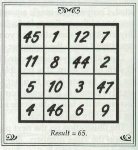 While memory feats can be amazing on their own, a reason for performing them can help make them far more interesting to your audiences. Here are a few plots I've come up with to use as starting points for memory feat presentations. I developed these on my own, and they're original as far as I know.
While memory feats can be amazing on their own, a reason for performing them can help make them far more interesting to your audiences. Here are a few plots I've come up with to use as starting points for memory feat presentations. I developed these on my own, and they're original as far as I know.
The first plot is a way to get two feats for the price of one. For this, you have to know how to do the Day of the Week For Any Date feat, and any 4 by 4 magic square routine in which the spectator starts by giving you 4 numbers to use in the square. You can find routines like this in Mathematical Wizardry, Mark Farrar's How To Create A Birthday Magic Square ebook, or Chuck Hickock's Diagonal Magic Square (now out of print).
You start by asking for someone's birthday, give the day of the week for it, and have the day of the week verified via a perpetual calendar. Mention that you're often asked how you figure the day of the week so quickly. Explaining that it's not so much a particular process, you explain that you simply see the numbers come together, much like in the movie A Beautiful Mind, or the TV show Numb3rs. You bring out a board marked with a 4 by 4 grid, and say that you're going to give them an idea of what happens when you think of the dates. You ask for a new birthday from someone, and fill those in as the 4 starting numbers in the grid. For example, if they say their birthday is October 12, 1974, you write the numbers 10 (October), 12, 19 (first 2 digits of the year) and 74 (last 2 digits of the year) in different boxes, according to the particular magic square method you're using. As you're writing the numbers, you figure out the day of the week for the date, and remember that for later.
Reminding them of how the numbers come together in your mind, you quickly fill out the rest of the squares. Once you're finished, you say, "...and this is how I know that this date falls on..." and give the correct day of the week (Saturday, in our October 12, 1974 example). Once the day is verified, you explain that part of the reason you knew this date was correct was that the numbers that flash in your head allow you to verify the answer from different perspectives. To explain, you show that all the seemingly-random numbers on the grid give the same total when added horizontally, vertically, diagonally and so on.
This plot is great for giving a Rain Man type of impression. For a larger audience, you could use a pre-made grid, such as Meir Yedid's Total Destiny. However, you can make it more theatrical with the use of a transparent dry-erase board, which will build the suspense as they see the numbers written backwards, and imposed on your face. There are some great discussions on the use of transparent dry-erase boards for routines like this in the Mentalist Sanctum and the members-only section of the Magic Cafe.
The second plot is simply the idea of a book puppet, which you claim is an almanac, an atlas or whatever type of book would have the information you've memorized. The book puppet effectively acts as the source for the answers you give in your memory feat. This is a small idea with many advantages. The book can be used for a metaphor restriction violation (see vol. 1 of Wonder Words), which is the technical term for attributing powers, actions or thoughts to something, the book puppet in this case, that obviously can't possess them. The effect of this is that the audience sees through this claim, and attributes the amazing recall of facts. Since this is done both subconciously and indirectly, it's much more effective and enjoyable than directly claiming an amazing memory. In the show Dr. Wilson's Memory Elixir, a drink with apparent memory-improving qualities is used in the same way.
Also, if you need to take the time to recall the information, you can have the book apparently whisper the answer to you. You can get a brief comedic moment by seeming to forget the information, and having the book remind you. Getting into a contest where you compete against the book to see who can answer more questions from the audience correctly could be very funny.
If any of you have any great plots for memory, math or other brain-related feats you would like to share, please include them in the comments!
0
Plots For Memory Routines
Published on Thursday, December 06, 2007 in magic squares, memory, memory feats, Numb3rs, products, psychology
Related Posts
Post Details
Posted by Pi Guy on Dec 6, 2007
Labels:
magic squares,
memory,
memory feats,
Numb3rs,
products,
psychology
Subscribe to:
Post Comments (Atom)




No Response to "Plots For Memory Routines"
Post a Comment